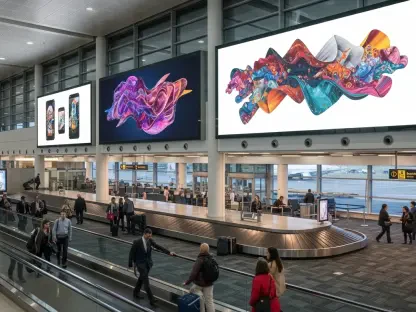Overview of OOH Advertising and Its Sustainability Focus
Imagine a bustling urban landscape where towering billboards and vibrant transit displays not only capture attention but also champion a greener planet. Out-of-Home (OOH) advertising, which includes formats like traditional billboards, digital screens, and public transit ads, stands as a global powerhouse in media outreach, spanning cities and rural areas alike. This industry, valued for its ability to engage audiences in public spaces, reaches millions daily with impactful messaging across diverse platforms.
In recent years, OOH has pivoted toward sustainability, emerging as a frontrunner among media channels in embracing environmental responsibility. This shift reflects a broader recognition of the need to reduce ecological footprints while maintaining commercial effectiveness. The commitment to green practices is evident in strategic initiatives that prioritize renewable energy and eco-friendly materials, setting a benchmark for others in the sector.
Key industry players, such as the World Out-of-Home Organization (WOO), alongside partnerships with entities like Ad Net Zero, are driving this transformation. These collaborations foster innovative frameworks and encourage the adoption of sustainable practices globally. Their efforts underscore a collective ambition to position OOH as not just a marketing tool, but a steward of environmental progress.
Key Sustainability Trends in OOH Advertising
Innovative Practices and Technologies
The OOH sector is witnessing a wave of eco-conscious innovations that redefine advertising’s environmental impact. Technologies such as LED lighting and solar-powered installations are becoming standard, significantly cutting energy consumption for illuminated displays. Additionally, living wall billboards, which incorporate greenery, are gaining traction for their ability to improve air quality in urban settings.
Beyond energy solutions, the industry is embracing sustainable materials to further its green agenda. The shift to PVC-free posters and the integration of recycled components in campaign designs reflect a mindful approach to resource use. These advancements ensure that brands maintain visibility without compromising on ecological values, blending aesthetics with responsibility.
The cumulative effect of these practices is a notable reduction in the industry’s carbon footprint. By prioritizing innovations that align with sustainability goals, OOH advertising demonstrates that effective marketing can coexist with environmental care. This balance is crucial as consumer expectations increasingly favor brands that exhibit genuine commitment to the planet.
Measuring and Reporting Emissions
Data-driven insights are shaping the sustainability narrative within OOH advertising, offering tangible evidence of its green credentials. In Germany, tools like the Green GRP reveal that OOH generates lower CO₂ emissions per 1,000 impressions compared to other media channels, highlighting its efficiency. Such metrics provide a clear benchmark for evaluating environmental impact across advertising formats.
In the UK, a remarkable milestone has been achieved, with 90 percent of OOH energy now sourced from renewables. This progress, supported by systematic tracking and reporting, showcases the sector’s dedication to clean energy adoption. Transparent measurement practices ensure that stakeholders can assess and improve their sustainability performance continuously.
Looking ahead, the development of precise measurement tools and standardized metrics is set to further strengthen the industry’s environmental accountability. From 2025 to 2027, advancements in emission tracking are expected to refine data accuracy, enabling OOH operators to make informed decisions. This forward-thinking approach solidifies the sector’s role as a leader in responsible media practices.
Challenges in Implementing Sustainable OOH Practices
Adopting sustainable practices in OOH advertising is not without hurdles, as financial and logistical barriers often impede progress. The high initial costs associated with installing renewable energy systems or sourcing eco-friendly materials can deter smaller operators from embracing green solutions. These expenses pose a significant challenge, particularly in markets with limited budgets for infrastructure upgrades.
Operational complexities also arise when measuring emissions across the diverse array of OOH formats, from static billboards to dynamic digital screens, especially in varied global markets. Inconsistent data collection methods and a lack of universal standards complicate efforts to present a unified sustainability profile. This fragmentation can undermine the credibility of environmental claims if not addressed systematically.
Potential solutions lie in fostering industry collaboration and investing in scalable technologies that lower entry barriers. Partnerships among stakeholders can facilitate shared resources and knowledge, reducing costs for sustainable implementations. Moreover, incentivizing innovation through grants or regulatory support could accelerate the adoption of green practices, ensuring broader accessibility and impact.
Collaborative Frameworks and Industry Standards
A pivotal development in OOH sustainability is the partnership between WOO and Ad Net Zero, aimed at enhancing the Global Media Sustainability Framework (GMSF) for sector-specific needs. This collaboration focuses on integrating accurate emission measurement techniques tailored to the unique operational dynamics of OOH formats. The result is a more relevant and actionable framework for industry players worldwide.
Transparency and consistency in climate reporting are central to this initiative, as emphasized by industry leaders. By aligning OOH operations with standardized guidelines, the partnership ensures that environmental data reflects real-world practices, fostering trust among advertisers and consumers. This unified approach is essential for scaling sustainable efforts across diverse markets.
The WOO Global Sustainability Task Force plays a critical role in embedding green practices into the industry’s core strategies. Supported by regulatory and voluntary standards, the task force drives policy alignment and encourages best practices. Additionally, platforms like the WOO Sustainability Hub enable global dialogue, allowing members to exchange innovative ideas and case studies for a more sustainable future.
Future Outlook for Sustainability in OOH Advertising
The OOH industry is well-positioned for responsible growth, leveraging refined sustainability metrics and widespread renewable energy adoption. As digital OOH continues to expand, integrating energy-efficient technologies will be key to maintaining a low environmental impact. This trajectory suggests a future where advertising in public spaces aligns seamlessly with ecological priorities.
Emerging disruptors, such as advancements in digital displays and breakthroughs in eco-friendly materials, are likely to reshape the sustainability landscape. These innovations promise to further minimize waste and energy use, enhancing the sector’s green profile. Staying ahead of such trends will require continuous adaptation and investment from industry stakeholders.
Platforms like the WOO Sustainability Hub are expected to remain instrumental in fostering collaboration and knowledge sharing. By serving as a repository for global best practices, this digital resource empowers OOH professionals to implement actionable solutions. The ongoing dialogue facilitated by such initiatives will be crucial in navigating the evolving demands of a greener advertising ecosystem.
Conclusion: OOH as a Green Media Leader
Reflecting on the strides made, the OOH industry has demonstrated a steadfast commitment to sustainability through groundbreaking partnerships and innovative practices. Collaborations like those between WOO and Ad Net Zero have paved the way for refined frameworks that prioritize accurate emission measurements. The sector’s low carbon footprint, bolstered by renewable energy adoption, underscores its role as a trailblazer in media responsibility.
Moving forward, stakeholders should focus on scaling collaborative efforts to address remaining challenges, such as cost barriers and inconsistent reporting. Investing in accessible green technologies and advocating for supportive policies emerge as vital steps to broaden sustainability adoption. These actions promise to solidify OOH advertising’s standing as a model for environmental stewardship.
Lastly, embracing continuous innovation offers a pathway to anticipate and adapt to future disruptions in the media landscape. By prioritizing platforms for global knowledge exchange, the industry can sustain momentum in its green initiatives. This proactive stance ensures that OOH remains at the forefront of balancing commercial growth with planetary well-being.









